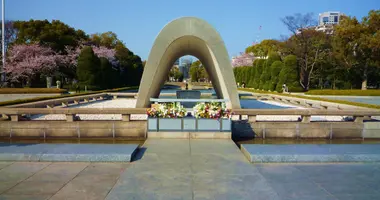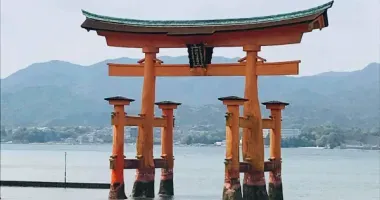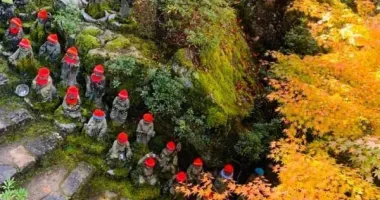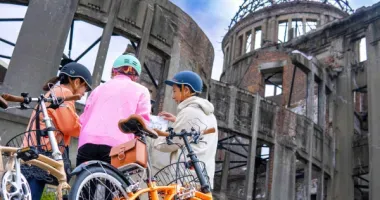Shimanami Kaido Cycling
The Shimanami Kaido is a 60 kilometer cycle-friendly expressway that links the main island of Honshu with Shikoku via a series of bridges connecting half a dozen islands.
Shimanami Kaido, one of the best bike rides in the world しまなみ海道
Jake Davies
The Shimanami Kaido is a 60 kilometer expressway that links the main island of Honshu with the island of Shikoku via a series of bridges connecting half a dozen islands in-between.
Though an expressway, each of the bridges can be used by cyclists and pedestrians, and each island has a well-marked cycle path to the next bridge, creating a cycle route of 70 kilometers that is quite probably the best cycle route in Japan and certainly among the most impressive bike routes in the world.

Shimanami Kaido
Located in Hiroshima Prefecture, from 2006 Ikuchijima has been part of Onomichi City. Since 1999 Ikuchijima has been connected to the mainland by the Shimanami Kaido, a road linking Onomichi with Imabari on Shikoku that passes through six islands via seven bridges.
The bridge connecting Ikuchijima with Omishima, named Tatara Bridge, is particularly graceful with a center span of 890 meters and was the longest cable-stayed bridge in the world when it was built.

Mukaishima across the channel from Onomichi, the start point of the Shimanami Kaido

The view from Mount Shirataki on Innoshima
Encompassing great beaches, fantastic vistas across the Inland Sea, pirate hideouts, hot springs, plenty of history, and a surprising amount of art, the route is cycled by an increasing number of foreigners of all ages and levels of fitness.
At seventy kilometers, many avid cyclists ride the route one way in a single day, but for those who enjoy a more leisurely pace and believe the journey is more important than reaching the destination as quickly as possible, then two, three or more days can easily be spent enjoying the sites and experiences scattered across the islands.

Innoshima Bridge, Shimanami Kaido

Kosanji on Ikuchijima
Onomichi
The route begins in Onomichi, Hiroshima Prefecture, a small town clinging to the hillsides, that has been used as a location in numerous movies and is probably most famous for its Temple Walk that visits the more than average number of temples in the town. A half day or even a full day could easily be spent here before heading off.

Sunset from the free campsite on Michikajima
Mukaishima
The first island is Mukaishima, though it is recommended that you take the short ferry across the channel as the first bridge is quite a way out of town, has no dedicated bike lane, and involves quite a climb to reach.
There is not a lot to see on Mukaishima, though there are a few guest houses that offer an alternative to overnighting in Onomichi itself. The bike path soon leaves the main town and reaches the coast with views that open up across the Inland Sea.
The first bridge that crosses over to Innoshima is a "double-decker," with the bike path on a level underneath the main roadway.
Innoshima was one of the bases for the infamous Murakami pirates who controlled the area and a fake castle is one of the tourist sites on the island. Off the bike route itself, on top of 227 meter high Mount Shirataki, fantastic 360 degree views over the surrounding island can be had while exploring the hundreds and hundreds of Buddhist statues on the mountaintop.

Kurushima Kaikyo Bridge
Ikuchijima
The next island, Ikuchijima is reached by the Ikuchi Bridge on which bikes and pedestrians have their own section of the bridge with only a waist height steel fence which allows for great views.
This is part of the uniqueness of this bike route because the bridges are quite high so you get unusual views looking down on the surrounding landscape. You can easily spend half a day on Ikuchijima as it is home to several places worth a visit including the fantastic complex of attractions at Kosanji, possibly the most unique temple in Japan.
Ikuchijima also has a nice long stretch of white sand beach and a series of modern art sculptures dotted around the island. The iconic Tatara Bridge takes you over to Omishima Island, the largest of the chain along the Shimanami Kaido, and the one most deserving of a diversion off the official bike route.
The bike route passes along just a short section of the southeast corner of Ikuchijima but the rest of the island has many places of interest. These include some great art galleries and a unique museum of architecture.

View from the Kurushima Kaikyo Bridge
Oyamasumi Shrine, which is set in an ancient forest, has the best collection of historical samurai armour and weaponry in all of Japan.
From the north of Ikuchijima a short ferry ride takes you to the tiny island of Okunoshima - a place with a troubled history that is now populated by thousands of rabbits.
If you don't want to carry on to Shikoku another short ferry ride away is the Aki Nada Islands, a chain of small islands which are also connected to each other by bridges and are home to a bike route that will take you back towards Kure and Hiroshima.
These first four islands are all part of Onomichi City in Hiroshima, but the next two are part of Imabari in Ehime on Shikoku. A relatively short ridge connects to Hakatajima, and like Omishima the cycle route passes just along a short part of its coast.
Off the cycle route there are parks and beaches, but the island is mostly known for salt production, so such delicacies as Salt Ramen and Salt Ice Cream can be sampled.
The final island before reaching the mainland of Shikoku is Oshima, "big island", one of hundreds of islands in Japan having the same name.
Oshima was another base of the Murakami pirates and there is a small museum dedicated to them here. At the southern end of the island a great viewpoint at the top of 300 meter high Mount Kirosan offers panoramic views and there are two places where short scenic boat trips can be taken.
The final bridge over to Shikoku, the Kurushima Kaikyo Bridge, is perhaps the most impressive, at over six kilometers in length, including the long approaches for bikes, it is actually three connected suspension bridges, the first of its kind in the world, and the views are stupendous.
Once you reach the mainland it's then just a six kilometer cycle into Imabari, a castle town that is home to several of the temples on the famous Shikoku 88 temple pilgrimage.

Arriving on Shikoku, the bike ramp from the Kurushima Kaikyo Bridge
Access & Practicalities
The Tourist Information Offices at either end of the Shimanami Kaido, Onomichi and Imabari, both have maps and extensive information in English on the route and can help with booking accommodation and making bike reservations. Both are located right at the main railway stations.
Imabari Tourist Information Office
1-729-8 Kitahoraicho, Imabari, Ehime
Tel: 0898 36 1118
Onomichi Tourist Information Office
1-1 Higashigoshocho, Onomichi, Hiroshima
Tel: 0848 20 0005
You can of course bring your own bikes, but for visitors there are now two rental options. The standard system has 14 locations along the route. Regular bikes are 1,000 yen a day, kids bikes 300 yen a day.
A 1,000 yen deposit is returned if you return your bike to the depot you rented from. Electric-Assist bikes are 1,500 yen a day and tandems are 1,200 yen a day. Both must be returned to the location you rented them.
A new system has recently started up using higher quality bikes, albeit at higher prices. Operated by Giant, the biggest bike manufacturer in the world, there are just two locations, one in Onomichi and one in Imabari. The one in Onomichi also has a unique hotel catering to cyclists. Prices range from 4,000 to 13,000 yen depending on bike type, with various conditions. More details
Giant Onomichi
5-11 Nishigosho-cho, Onomichi, Hiroshima. Tel: 0848 21 0068
Giant Imabari
1-729-8 Kita Hourai-cho, Imabari, Ehime. Tel: 0898 25 1175
Public Transport
There are buses that run between Imabari and Onomichi, but needing a transfer on Innoshima, there are also local buses on each of the islands. Ferry services include Onomichi and Mihara in Hiroshima running to and from Setoda on Ikuchijima, and a ferry from Imabari that stops at Oshima and Hakatajima before going on to some of the smaller islands that are not part of the Shimanami Kaido.
In Imabari and Onomichi at either end of the route are a full range of hotels, and there are numerous accommodation options, mostly minshuku or ryokan, all along the route, and in general it is best to book in advance if possible, however, outside of the busiest times it is still possible to find places to stay at shorter notice.
There are also numerous campgrounds, the one on Omishima near the Tatara Bridge offering particularly spectacular views, but mention must be made of a free campground accessible only to cyclists or pedestrians. It is reached from the bridge connecting Hakatajima to Oshima, where the bridge touches the small uninhabited island of Michikajima. There is running water and toilets, but no other services, but a fantastic place to watch the sun set. Outside of the busiest times the chances are you will have the whole island to yourself.




















